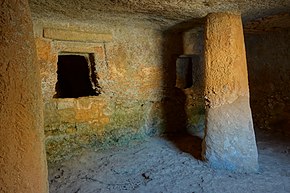Necropolis of Anghelu Ruju

Entrance of one of domus de janas
|
|
| Location | Alghero, Sardinia, Italy |
|---|---|
| Type | Burial |
| History | |
| Periods | Neolithic, Chalcolithic, Bronze Age |
| Cultures | Pre-Nuragic Sardinia |
The necropolis of Anghelu Ruju is an archaeological site located in the town of Alghero, Province of Sassari, Sardinia. This is the largest necropolis of pre-Nuragic Sardinia.
The necropolis was discovered accidentally in 1903 during the excavations for the construction of a farmhouse, in the winery of Sella&Mosca. In that occasion were found a human skull and a tripod vessel. Following these discoveries, the archaeologist Antonio Taramelli effected, the following year, the first excavations of the site. In total were discovered 38 domus de janas.
Within the many chambers are numerous finds of grave goods (vases, statuettes of the hypothesized "mother goddess", weapons, necklace beads etc.), which allow us to date the necropolis to the Late Neolithic (Ozieri culture 3200-2800 BC) and they attest its use even in the Copper and the early Bronze Age, between 2800 and 1600 BC, (cultures of Abealzu-Filigosa, Monte Claro, Bell Beaker, Bonnanaro). Furthermore, finds of flint tools, mace-heads, arrowheads, axes and beads suggest a culture which emphasized hunting and warrior prowess; whereas silver rings, copper daggers appearing to originate from Spain, an awl which likely was from southern France, a copper ring of an eastern European style, and an axe which was from the British Isles indicate that Sardinia was heavily involved in this time period with a great deal of international trade. The Sardinians, for their part, were known to possess an ample amount of valuable obsidian from Monte Arci, a long-dormant volcano on the island.
...
Wikipedia
